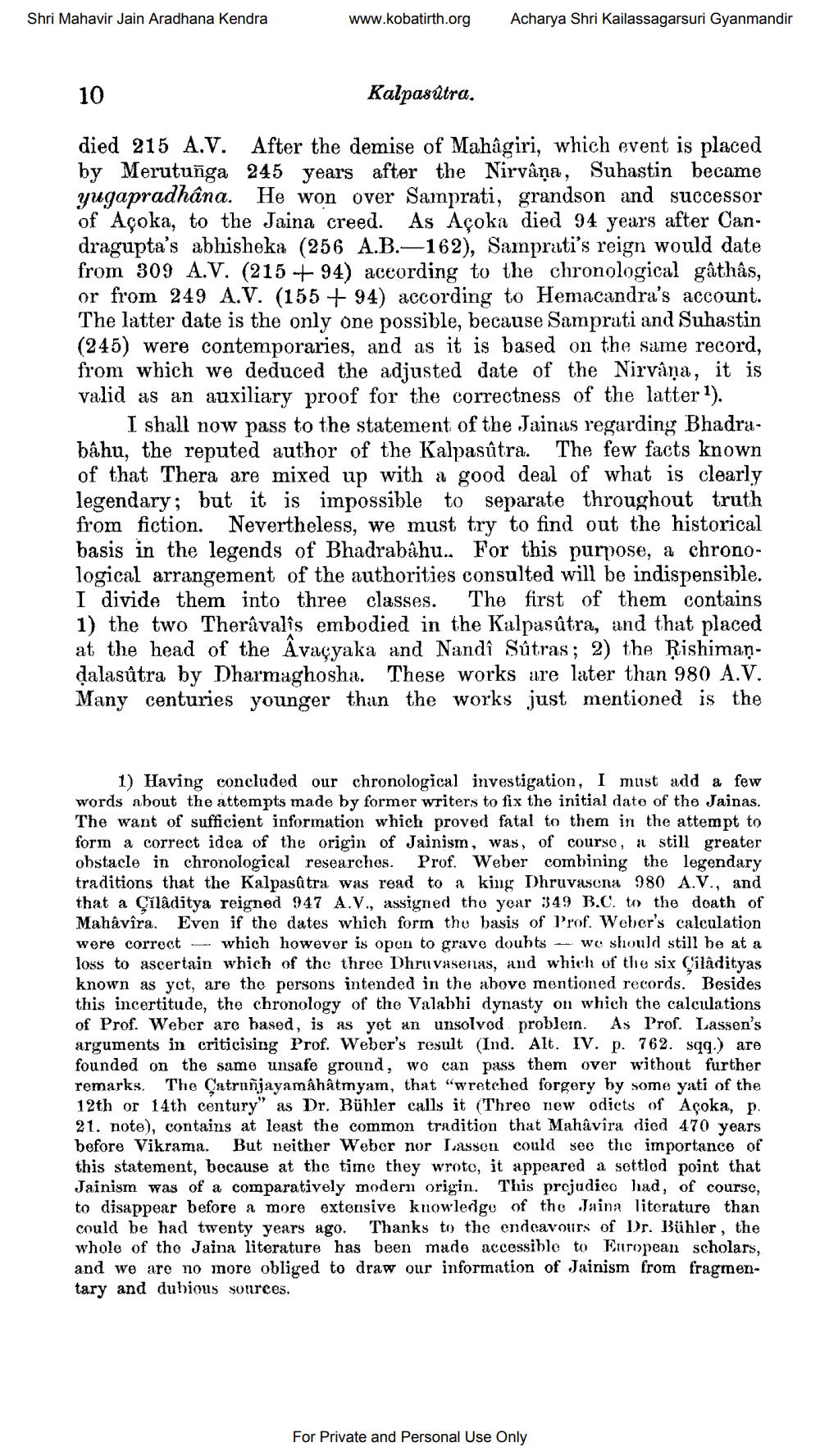________________
Shri Mahavir Jain Aradhana Kendra
www.kobatirth.org
Acharya Shri Kailassagarsuri Gyanmandir
10
Kalpasútra.
died 215 A.V. After the demise of Mahâgiri, which event is placed by Merutuñga 245 years after the Nirvana, Suhastin became yugapradhana. He won over Samprati, grandson and successor of Asoka, to the Jaina creed. As Açoka died 94 years after Candragupta's abhisheka (256 A.B.—162), Samprati's reign would date from 309 A.V. (215 +94) according to the chronological gâthâs, or from 249 A.V. (155 +94) according to Hemacandra's account. The latter date is the only one possible, because Samprati and Suhastin (245) were contemporaries, and as it is based on the same record, from which we deduced the adjusted date of the Nirvana, it is valid as an auxiliary proof for the correctness of the latter ).
I shall now pass to the statement of the Jainas regarding Bhadrabâhu, the reputed author of the Kalpasútra. The few facts known of that Thera are mixed up with a good deal of what is clearly legendary; but it is impossible to separate throughout truth from fiction. Nevertheless, we must try to find out the historical basis in the legends of Bhadrabahu.. For this purpose, a chronological arrangement of the authorities consulted will be indispensible. I divide them into three classes. The first of them contains 1) the two Therâvalis embodied in the Kalpasútra, and that placed at the head of the Âvaçyaka and Nandî Sûtras; 2) the Rishimandalasútra by Dharmaghosha. These works are later than 980 A.V. Many centuries younger than the works just mentioned is the
1) Having concluded our chronological investigation, I must add a few words about the attempts made by former writers to fix the initial date of the Jainas. The want of sufficient information which proved fatal to them in the attempt to form a correct idea of the origin of Jainism, was, of course, a still greater obstacle in chronological researchos. Prof. Weber combining the legendary traditions that the Kalpasûtra was read to a king Dhruvasena 980 A.V., and that a Çilâditya reigned 947 A.V., assigned the year 349 B.C. to the death of Mahâvîra. Even if the dates which form thu basis of Prof. Weber's calculation were correct - which however is open to grave douhts - we should still be at a loss to ascertain which of the three Dhruvasenas, and which of the six Çilâdityas known as yet, are the persons intended in the above mentioned records. Besides this incertitude, the chronology of the Valabhi dynasty on which the calculations of Prof. Weber are based, is as yot an unsolved problein. As Prof. Lassen's arguments in criticising Prof. Weber's result (Ind. Alt. IV. p. 762. sqq.) are founded on the same unsafe ground, we can pass them over without further remarks. The Catrunjayamahatmyam, that "wretched forgery hy some yati of the 12th or 14th century" as Dr. Bühler calls it (Threo new odicts of Açoka, p. 21. note), contains at least the common tradition that Mahâvîra died 470 years before Vikrama. But neither Weber nor Lassen could see the importance of this statement, because at the time they wrote, it appeared a settled point that Jainism was of a comparatively modern origin. This prejudico had, of course, to disappear before a more extensive kuowledge of the Jaina literature than could be had twenty years ago. Thanks to the endeavours of Dr. Bühler, the whole of the Jaina literature has been made accessible to European scholars, and we are no more obliged to draw our information of Jainism from fragmentary and dubious sources.
For Private and Personal Use Only




